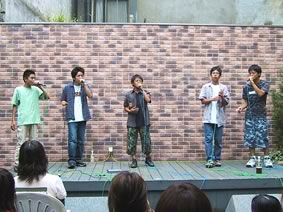
A cappella music is the rage among young people in Japan. A cappella refers to vocal music performed without instrumental accompaniment. Originally Italian, a cappella means "in chapel style." But ensembles that perform this type of music don't necessarily specialize in church or gospel songs. The groups that are popular in Japan are much more laid back, and they sing songs of various genres, from R&B to rap, in beautiful harmony.
If you think that pops and rock songs can't be performed without instruments, there's no need to worry: There are vocal parts that imitate the sounds of instruments. The person in charge of the part known as "voice percussion" makes sounds in the mouth and throat just like the drums, tambourine, and other percussion instruments - like "doon doon" and "zum zum zum." Among young Japanese fans of a cappella music, this part is known as boipa (short for boisu pakasshon, the Japanese pronunciation of "voice percussion"). There is also a bass part, in which the vocalist imitates the bass guitar. The addition of the boipa and bass makes it possible to perform a cappella songs that are rhythmic and danceable. The boipa is a difficult but popular part, and people who can do it are considered cool.
The current a cappella boom was sparked by the song "Hitori" (Alone), which was released in March 2001 by a Japanese all-male quintet called the Gospellers, whose members are all graduates of Waseda University. It was their first hit song in the seven years since their professional debut, and the CD single sold more than 600,000 copies in the first six months after going on sale.
Soon after, a popular variety show on television started a section called "Hamonepu" (short for "Harmony Neptune," combining the word harmony with the name of the comedy group that hosts the show), in which young amateur ensembles compete by performing their own arrangements of hit songs of various genres. Many middle and high school students across Japan who had been viewing the show began forming a cappella groups and applying to take part in the competition, and the overall skill level of the participants steadily grew higher. From among the contestants in the "national championships" that the show held in July and December 2001, three groups - Chin Para, Rag Fair, and Inspi - have made their professional debuts. They have all become quite popular, and songs by Chin Para and Rag Fair have even made it into the top 10.
This year, more new units have continued to appear on the music scene: Baby Boo in February, Aji in June, and Chicken Garlic Steak in August, to name but a few. Moreover, a cappella songs can now be heard much more frequently in TV commercials.
On August 25 the third national contest was held among 18 ensembles that had won the regional rounds, which started in April with the participation of about 5,000 teams. More than 60% of these teams were made up of elementary, middle, and high school students.
According to one young enthusiast, the best part about doing a cappella is that "it's really thrilling when we get a good harmony, and it's also a good way to make friends." Contests and other events are being held across the country, and many schools have been setting up a cappella clubs. Another appeal of the music for school students seems to be that it doesn't cost any money to get started, since it involves no musical instruments.
Photo: The amateur a cappella group Karisuma (Charisma) is made up of four middle school boys and one high school boy. ( Y. Hayashida)
|

